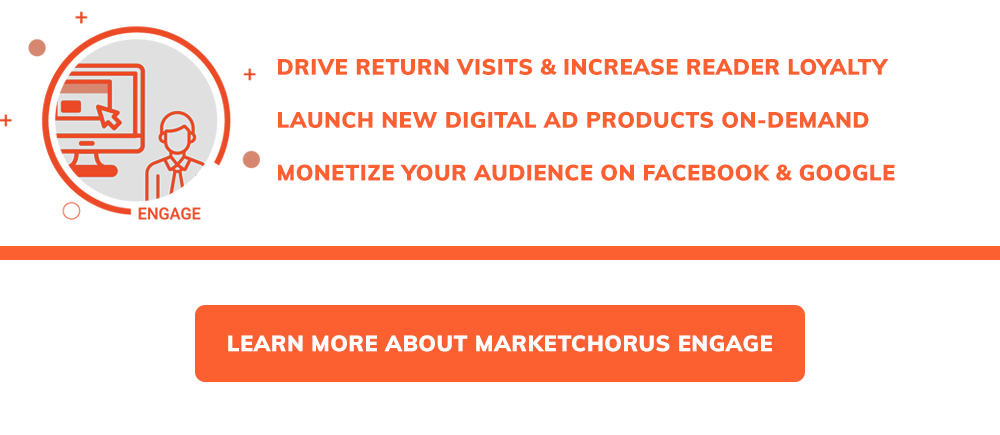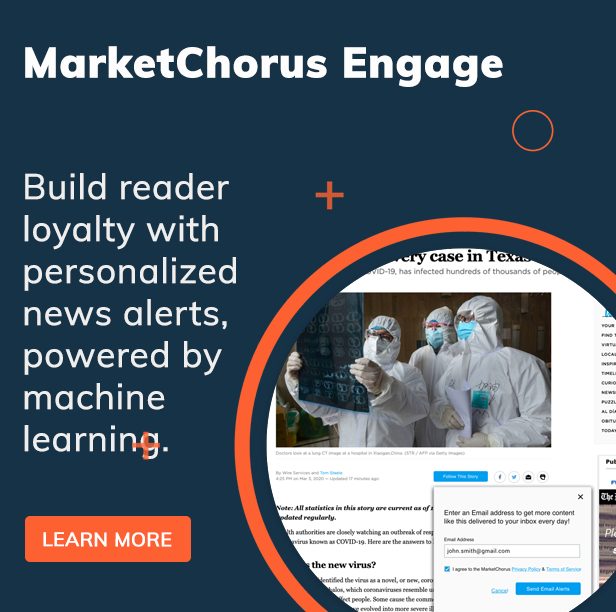Google recently announced that it would be phasing out support for cookies in Google Chrome, the backbone of the programmatic industry. Ironically, their own Google Display Network (worth $116B annually and growing) is built on the technology. (Source: Forbes)
Obviously the advertising mega-giant is hard at work innovating new solutions to replace the need for cookies, but at the moment, there is no standard in place to support industry worth hundreds of billions of dollars each year.
The traditional ad industry was flipped on its’ head when the invention of browser cookies enabled digital ad platforms to track an individual across the web, gathering little bits of personally-identifiable information along the way.
Before cookies and pixel tracking, advertisers primarily relied on adjacency to reach their target audiences. Brands purchased ads in the relevant sections of newspapers, billboards in the right areas of town, and television commercials during particular shows to reach potential buyers.
The context of the advertisement matters in traditional advertising. Who you reach is a result of where you place your ads.
In digital advertising the location of your ads is a lot less tangible and, thanks to cookies, targeting tends to be based on what data you have on the viewer, rather than where your ads appear.
This sounds very appealing to advertisers. At face value, it seems like targeting potential buyers using demographic and behavioral data would be much more efficient. If you can always reach the right type of people, who behave like your best customers, in theory, you should have a high degree of success with your advertising.
But that’s not what has happened…

Digital advertising is fraught with inefficiencies and plagued by bad data. The results from (especially programmatic) campaigns that rely on third party data are often less reliable than their traditional counterparts due to low quality data, ad fraud, and other factors.
“For every $3 spent on digital ads, fraud takes $1”
“Click fraud is currently growing at 50% per year”
(Source: PPC Protect)
And some estimates are far less flattering, depending on the types of ads, their format, and cost per click. Some ad positions, such as 300×600 desktop units, are more profitable and, thus, more likely to be abused by click bot networks.
What the demise of PII and cookies means for publishers
Publishers got a raw deal out of the last 10 or so years of disruption in the advertising industry. Hundreds of millions of dollars a year drained out publishers’ pockets while Google and Facebook consolidated the world’s advertising power into two privately operated networks.
It’s now cost prohibitive to sell ads without relying on Google or Facebook as the mechanism for targeting and serving them.
The ad industry became so reliant on third party data for targeting that few campaigns are sold without incurring pricey data fees, reducing margins to a few cents per impression.
All of this means that your advertisers are paying high fees for poor quality results and your margin is dramatically smaller as a result.
Your sales team is doing all the work and you’re paying Google and Facebook most of the advertising revenue, even though you’re forced to report lackluster results to your customers.
This situation is clearly unsustainable and, as a publisher, you should be rejoicing about the impending demise of cookies and how it will force advertisers to confront their addiction to third party data.
Today digital advertising relies on personally identifiable information like demographic and behavioral data. In the near future PII data will likely be replaced by contextual data, that is, data gathered on what content users are viewing and how and when they do so.
And publishers are better positioned to capture contextual data than anyone…
Now is the time for taking bold steps to take back your share of ad dollars, by implementing systems and software that generate your own, entirely differentiated, first party contextual data.
In plain english, publishers know what people read -and you are what you read.
Or at least, you can infer a lot about your audience, and what interests them, from what they read.

There’s the audience and then there’s the engaged audience
Publishers have a unique opportunity to monetize first party data contextual data. You know so much about your readers based on the content they consume on your websites.
You can learn a great deal more about your most engaged segments by examining the content they share on social media.
Simply put, there’s the audience reading your content and there’s the engaged audience who shared or commented on social media. Both can be monetized, either together or separately.
Your readers are loyal. They come back again and again to read your content. Since you know what interests them, you can splice and intersect that data into dozens (maybe hundreds) of niche audiences based on the content they read.
Social networks are our communal consciousness, in-the-cloud, and this is where the engaged audience resides. This audience is, mostly, a subset of your readers who were interested enough to take action.
And it’s safe to assume a percentage of those people are interested enough to take additional actions, if prompted. An engaged audience (active on social media) can be leveraged by brands for all kinds of community-building initiatives.
Take these two hypothetical situations as examples:
First example: You’re selling ad campaigns to roofing companies targeting people in their area reading articles on your site about insurance, home repair, and aging parents (all 3). That’s your audience. No one else has this data.
Second example: You’re selling ad campaigns to local opera houses and theaters targeting people who not only read, but shared, articles on your site about shows, plays, musicals, etc. The ad campaign promotes an “Enter to win tickets” contest, where you can earn extra entries by sharing the contest on social media.
Both scenarios could be very compelling to the right advertisers, creating opportunities your ad sales team can harvest.

How do you create new ad products based on the audience you already own?
This is your audience we’re talking about, and you already sell them to advertisers, so how is this strategy any different from what you’re already doing?
The difference is location.
You already sell your website views. Those views are generated by your readers. Your readers spend time on other websites, social networks, YouTube, etc. and you can sell those views as well.
How do you do this?
Our platform, MarketChorus Engage, provides publishers the ability to instantly search their library of content for articles related to any topic and export the readers of that content to Facebook, Google, and other ad platforms as retargeting audiences.
If you’re not familiar, the technique of advertising to your website visitors when they’re on other websites (or social networks) is called retargeting.
MarketChorus Engage pairs retargeting technology with natural language processing and machine learning algorithms to sift through all of your content in milliseconds, exporting a list of articles related to any given search.
Then the audience of website visitors who’ve read this content are exported into a retargeting audience on any platform with retargeting capabilities, like Facebook, Google, etc.
Stated simply, you create revenue by selling ads to your readers while they’re on Facebook, for example, using a retargeting audience automatically created and maintained by MarketChorus’ AI technology.
And the best part is, when you advertise with retargeting audiences, the cost of advertising drops dramatically, providing your customers a better value and you an opportunity to take a higher margin.
The engaged audience is a different ad product to sell -but it can be bundled!
When we described retargeting above, we’re talking about your audience (readers on your website). That subset of your readers we refer to as the engaged audience, is a little different…
Our AI interacts with the Twitter API to extract the list of accounts which have shared any URL or commented on any post in which that URL was shared.
And, separately, it digests all the text in the articles that match a given search into entities (phrases representing people, places, and things) and matches those to longtail interests on Facebook.
MarketChorus enables you to reach anyone who shared or commented on a relevant article on Twitter and, on Facebook, anyone who has demonstrated prior interest in the topics covered within relevant articles.
Selling your engaged audience means executing Facebook and Twitter ad campaigns on behalf of your clients, targeting the people who are actively engaging with relevant content on social media.

How does the publisher profit in these scenarios?
Now the important part…revenue!
If your team has sold Facebook and Google advertising campaigns before you’ll be accustomed to paying high fees for targeting data.
Google shares this cost transparently with your ad execution team when they’re building the digital ad campaigns. Facebook is less transparent, but rest assured, they’re also adding data fees into the total they charge you for a campaign.
Retargeting campaigns don’t include data fees -because you’re supplying the targeting data!
This typically saves you several dollars per 1,000 views (CPM). Using your own data for targeting enables you to pocket the data fees, significantly increasing your margin.
There are various ways to manage this transaction with your customers:
- You could be transparent, deliver more impressions within their budget and take a higher margin.
- You could sell the campaign on a performance basis, guaranteeing a fixed number of clicks and keeping the difference (which is hugely profitable).
- You could be transparent with the ad platform cost (Facebook, Google, etc.) and then levy data fees of several dollars (CPM) on top.
- You can sell pay per click campaigns, arbitraging between the CPM cost you’re paying and what CPC the market will bear.
You have a great deal of flexibility when creating your own ad products instead of simply reselling typical display ad campaigns.
Anyone can sell ads on Google or Facebook’s display networks. It’s entirely commoditized. But to sell ads through those networks based on proprietary data that no one else has -that’s differentiated.
Differentiation is just another word for unique value. In a landscape like digital marketing, littered with so many undifferentiated options, being able to provide unique value not only makes you stand out…it can improve your results as well.
Happy customers are sticky customers. Sticky customers become advocates and help you unlock more revenue. Offering something special, different, and effective, will give your ad sales team a strategic advantage when out in the field, selling your digital wares.
Our platform, MarketChorus Engage, leverages your reader data to enable you to build custom advertising audiences on platforms like Facebook, Google, Twitter, YouTube, and other networks.
Talk to MarketChrous to learn how to leverage your reader data to build proprietary digital ad products and increase your share of digital ad dollars.




